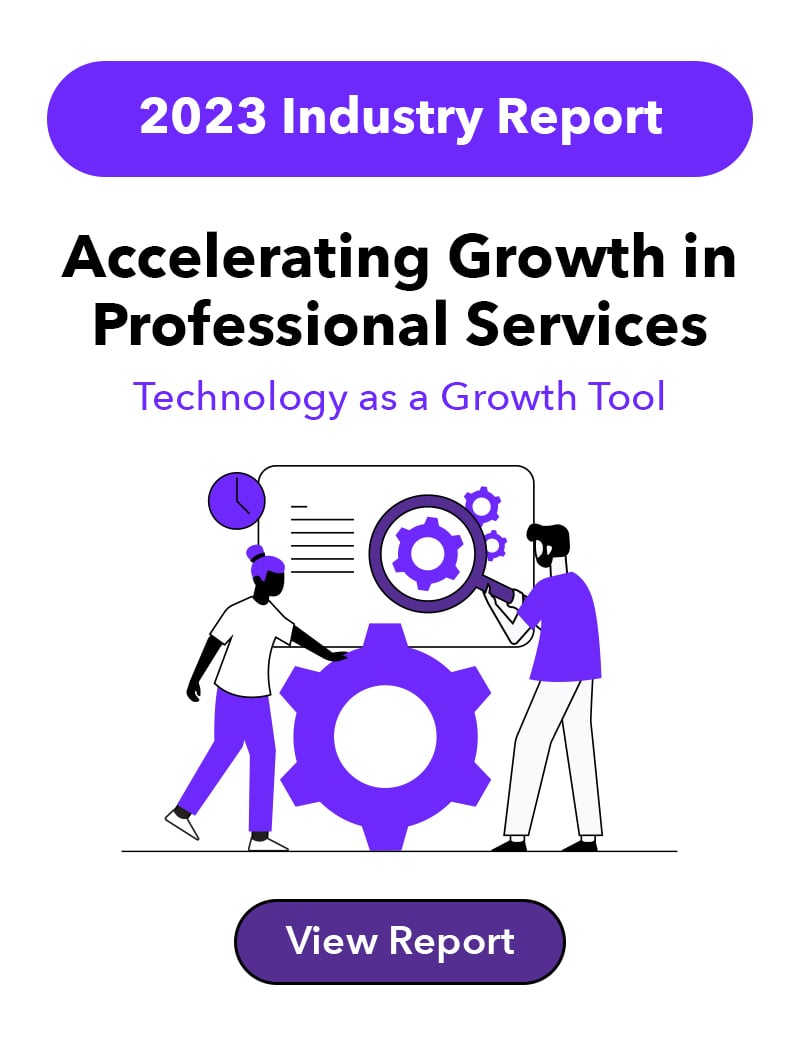When you’re working inefficiently, you reduce your firm’s ability to grow and prosper. Operational inefficiencies can also hold your professional services firm back from adjusting to company and industry roadblocks, like shrinking budgets, increased competition and market instability.
Here’s some news that came out in the last few years alone:
- Marketing budgets dropped to 6.4% of company revenue in 2021.
- Global professional services are expected to grow by 9.1% between 2023 – 2030, increasing competition.
- The risk of recession is rising as the Federal Reserve has raised interest rates in response to high inflation.
The time to ditch manual, inefficient processes is now. Firms must be able to quickly identify where they can reduce waste and increase process efficiency in order to do more with less.
But what’s more, their employees will ultimately demand it.
When firms work inefficiently, employee experience suffers which can lead to burnout, high turnover, reduced productivity and decreased engagement. When professional services firms enact process efficiency measures, synergy is created between teams and repetitive work is automated, leading to happier employees.
There are five signs that your professional services firm is operating inefficiently:
- Consistently long turnaround times to complete services for clients.
- The majority of your processes are manual.
- You don’t have adequate employees or technology to keep up with demand.
- Your teams don’t talk to each other.
- Your clients receive inconsistent services.
Having just one of these signs is bad, but two, three or more means your firm could be suffering from severe operational inefficiencies.
Here’s a deeper look into each indicator.
Long Turnaround Times
Turnaround time is the amount of time it takes to complete a process. In professional services, that could mean the amount of time it takes to get a proposal to a client or how long it takes your team to complete an internal process.
Long turnaround times are not appreciated in any industry, but especially in professional services where you are often providing business-critical services. If you consistently take too long to deliver on client promises, your firm will quickly lose clients and money, stunting your future growth potential.
There are many causes for long turnaround times, but they basically boil down to not having enough staff, bad tools and slow processes.
For example, long turnaround times stem from the fact that:
- Your staff is overworked, spending too much time on mundane tasks.
- Your firm is consistently one worker or two short, leaving others to pick up the slack.
- Your technology is old and inefficient; using it causes your employees more headaches than completing tasks manually.
- Your system is so outdated, you’re struggling to update it.
- Your processes don’t reflect your firm’s changing strategic goals.
Keeping your customers satisfied and happy, and having a positive brand perception, means taking a hard look at your turnaround times and figuring out how they can be improved.
- Planning ahead so you don’t bottleneck or overburden your employees.
- Tracking your turnaround times so you have a clear view of how long your processes take.
- Encouraging your teams to communicate about deadlines and be transparent about where they are in the process.
- Making quick management decisions that will put processes back on track.
Over-Reliance on Manual Processes
Every firm has several important yet lengthy processes that are done manually, whether that’s pulling tombstone information or creating each client pitch from scratch. These consistent, repetitive processes can take up a huge amount of employee time.
In fact, 79% of the industry wastes a minimum of a quarter of their week on non-strategic tasks. The answer is to adopt digital transformation strategies that use software to update and automate your processes. Even though 50% of professional service leaders buy into the need for digital transformation, only 35% are currently utilizing digital tools for operational efficiency. So, what’s the deal? It could be a lack of change management processes - the processes that get employees on board with new technology. Buy-in needs to come from the top down whenever a firm is looking to implement a change. Once your top executives are on board, you can develop a digital transformation strategy that will prepare your entire team including IT and sales and marketing.
Ease of Use
It also helps to have a tool that your employees will want to use.
Ease of use is one of the biggest roadblocks to accepting new technology or software. A product like Pitchly’s data enablement software allows employees to quickly set up accounts while automating the tasks that take up much of their day.
For example, 45% of companies report it takes a week to prepare a business contract. Automating the process using templates and products like Pitchly’s Tombstone Builder, saves firms time. Pitchly software has been found to reduce the time firms spend collecting, finding, and using client experiences by more than 50%.
When you highlight the connection between software implementation and actual time saved to your employees, adoption rates will quickly climb. And once you automate your manual processes, your firm will benefit. Research shows that 44% of firms say that automating manual processes was a main growth-related goal for the upcoming year.
Inadequate Resource Allocation
How you allocate your firm’s resources plays a large role in how inefficiently you’re operating.
Resource allocation is the process of assigning and managing the assets that support your firm’s strategic planning goals. Assets can include both tangible and soft assets like hardware and people.
But when resources aren’t used efficiently, project costs go up while productivity and employee satisfaction go down.
There are several reasons why your firm is experiences inadequate resource allocation:
- There could be changes in project scope; you didn’t plan for enough resources for the change.
- You didn’t have enough resources to begin with.
- Not enough resources are available, i.e., your hardware or employees are involved in other projects.
- Your team isn’t working together.
- Your planning is inefficient.
To ensure you’re using the resources you have in the most efficient way possible, be sure to spread your resources out evenly across all your projects. Use technology that consolidates your data, allowing your employees to access it from one centralized platform.
And either hire or train your employees to have at least two or more skill sets. It’s more efficient to have several employees that can do a lot of things instead of each having their own separate specializations.
Lack of Collaboration Between Teams
Collaboration is key to counteracting an inefficient process.
Creating a collaborative working environment will improve your organization’s productivity, allowing every employee to thrive. Teams that are forced to work in silos will never be able to collaborate as efficiently as they should.
A data silo occurs when raw data is only accessible by one department, while being isolated from the rest of the firm. When this happens, there’s a severe lack of transparency and trust. Employees don’t talk because they have no idea what the other is doing.
Instead of creating silos, leaders should instead create a work culture that encourages employees to collaborate.
Having tools that everyone has access to is a good place to start. Technology, like project management software, can help get everyone on the same page while boosting collaboration. It’s up to leadership to get all team members to understand that everyone’s success is tied together.
Inconsistent Quality of Service
Achieving consistency in service means everything your firm puts out is uniformly executed, regardless of time. Offering inconsistent services could severely damage your firm’s ability to retain clients.
According to a study by PSM, decision makers at companies are reluctant to give work in new areas to inconsistent professional services firms because they do not know what they will receive as an end result.
The reasons for having an inconsistent quality of service can be attributed to your firm size, large firms seem to have more issues remaining consistent compared to smaller firms, or simply a lack of accountability when it comes to quality.
To counteract inconsistent outcomes, firms should focus on training all employees to strive to get the same result. This includes:
- Focus on training employees to pay careful attention to the cumulative experiences, not just the individual components. Every interaction is important.
- Train your employees effectively, focusing on consistent processes. When processes are consistent, you can measure performance and hold people accountable.
- Offer training to both new employees and refreshers for more established workers.
Working inefficiently can seriously hinder your firm’s ability to not only grow but simply maintain your current client list.
When customers continually experience long turnaround times and inconsistent quality of service – whether it’s from clunky manual processes or a lack of resources and collaboration – they likely won’t wait around for your firm to change.
With increased competition and shrinking budgets, firms need to address where their operational inefficiencies are and take steps to improve them. Upgrading technology is an easy way to start. There are tools and software that can speed up how your employees work, making them more productive and ultimately happier.
Data consolidation is one way all firms can improve their efficiency.
Pitchly offers products, like Data Workspaces, Forms, AI Assist, and Elements, to help employees effectively activate the data inside their organization to solve everyday information, content creation and document generation needs.
When access to data is automated, employees can use their time more wisely, instead of on repetitive tasks. Visit our Products page to learn more.
 May 9, 2023
May 9, 2023





